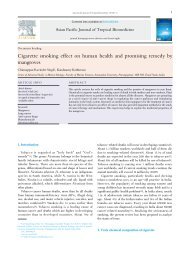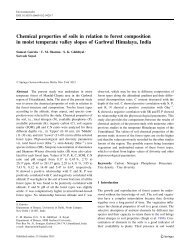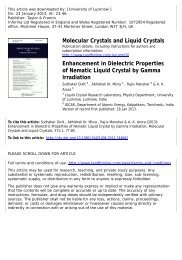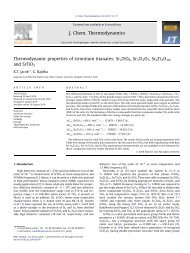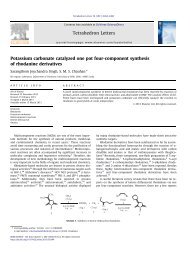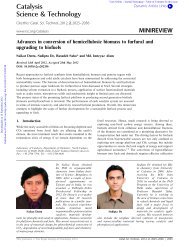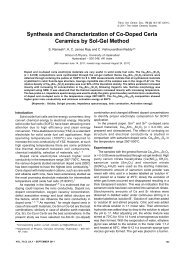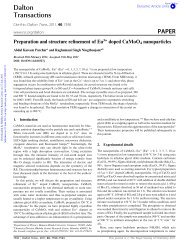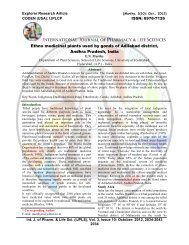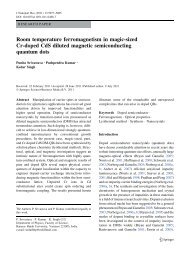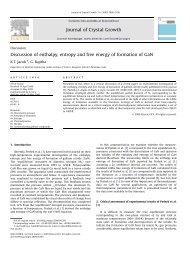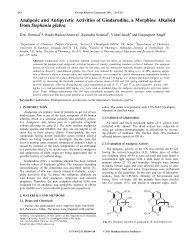Structural Characterization of Helices in - Dr. DS Kothari ...
Structural Characterization of Helices in - Dr. DS Kothari ...
Structural Characterization of Helices in - Dr. DS Kothari ...
Create successful ePaper yourself
Turn your PDF publications into a flip-book with our unique Google optimized e-Paper software.
Angewandte .<br />
Communications<br />
Hybrid-Peptide <strong>Helices</strong><br />
DOI: 10.1002/anie.201209324<br />
Promotion <strong>of</strong> Fold<strong>in</strong>g <strong>in</strong> Hybrid Peptides through Unconstra<strong>in</strong>ed<br />
g Residues: <strong>Structural</strong> <strong>Characterization</strong> <strong>of</strong> <strong>Helices</strong> <strong>in</strong> (agg) n and (aga) n<br />
Sequences**<br />
Krishnayan Basuroy, Bhimareddy D<strong>in</strong>esh, Narayanaswamy Shamala,* and<br />
Padmanabhan Balaram*<br />
The tendency <strong>of</strong> oligopeptides composed <strong>of</strong> g-am<strong>in</strong>o acids to<br />
fold <strong>in</strong>to helical structures was first observed by the groups <strong>of</strong><br />
Seebach and Hanessian <strong>in</strong> their studies <strong>of</strong> short g peptide<br />
sequences <strong>in</strong> solution. [1, 2] These observations, together with<br />
the reports on oligomeric b peptides, which emanated orig<strong>in</strong>ally<br />
from the groups <strong>of</strong> Seebach and Gellman, [3,4] fuelled<br />
a great deal <strong>of</strong> <strong>in</strong>terest <strong>in</strong> the design and formation <strong>of</strong> folded<br />
peptides (“foldamers”), [4c] <strong>in</strong>corporat<strong>in</strong>g the backbone-homologated<br />
analogues <strong>of</strong> the a-am<strong>in</strong>o acids. [5] The <strong>in</strong>corporation<br />
<strong>of</strong> unsubstituted b-, g-, and d-am<strong>in</strong>o acids <strong>in</strong>to folded<br />
structures formed by host a-am<strong>in</strong>o acid sequences has been<br />
extensively exploited <strong>in</strong> the design <strong>of</strong> polypeptide structures<br />
with hybrid backbones. [6] Crystallographic characterization <strong>of</strong><br />
novel hydrogen-bonded helices <strong>in</strong> oligo b-peptides and <strong>in</strong> ab,<br />
ag, and bg sequences has been possible <strong>in</strong> peptides conta<strong>in</strong><strong>in</strong>g<br />
stereochemically constra<strong>in</strong>ed b and g residues, <strong>in</strong> which the<br />
additional degrees <strong>of</strong> backbone torsional freedom have been<br />
limited either by cyclization [7] or by <strong>in</strong>corporation <strong>of</strong> gemdialkyl<br />
substituents. [8] Impos<strong>in</strong>g a conformational bias by<br />
us<strong>in</strong>g constra<strong>in</strong>ed residues has been shown to greatly enhance<br />
the crystallizability <strong>of</strong> relatively long oligopeptides sequences<br />
that conta<strong>in</strong> only a-am<strong>in</strong>o acids, a feature that is best<br />
exemplified by extensive studies <strong>in</strong> the solid state <strong>of</strong> peptides<br />
that conta<strong>in</strong> a-am<strong>in</strong>oisobutyric acid (Aib) or related a,adialkylated<br />
am<strong>in</strong>o acids. [9]<br />
Stimulated by the prelim<strong>in</strong>ary reports <strong>of</strong> folded structures<br />
<strong>in</strong> solution for peptides that conta<strong>in</strong> unconstra<strong>in</strong>ed g residues,<br />
[1,2] derived by homologation <strong>of</strong> the naturally occurr<strong>in</strong>g<br />
a-am<strong>in</strong>o acids found <strong>in</strong> prote<strong>in</strong>s, we embarked on a systematic<br />
survey <strong>of</strong> the conformational propensities <strong>of</strong> g residues<br />
derived from the genetically coded am<strong>in</strong>o acids. [10] Here<strong>in</strong>,<br />
we describe a mixed C 12 /C 14 /C 12 helical structure <strong>in</strong> an (agg) n<br />
sequence established <strong>in</strong> the crystals <strong>of</strong> the twelve-residue<br />
[*] K. Basuroy, Pr<strong>of</strong>. N. Shamala<br />
Department <strong>of</strong> Physics, Indian Institute <strong>of</strong> Science<br />
Bangalore-560 012 (India)<br />
E-mail: shamala@physics.iisc.ernet.<strong>in</strong><br />
B. D<strong>in</strong>esh, Pr<strong>of</strong>. P. Balaram<br />
Molecular Biophysics Unit, Indian Institute <strong>of</strong> Science<br />
Bangalore 560 012 (India)<br />
E-mail: pb@mbu.iisc.ernet.<strong>in</strong><br />
[**] This work is supported by <strong>in</strong>stitutional grant-<strong>in</strong>-aid from the<br />
Department <strong>of</strong> Biotechnology (DBT), India. B.D. is supported by the<br />
award <strong>of</strong> a UGC-<strong>DS</strong>K Postdoctoral Fellowship from the University<br />
Grants Commission (UGC), India.<br />
Support<strong>in</strong>g <strong>in</strong>formation for this article is available on the WWW<br />
under http://dx.doi.org/10.1002/anie.201209324.<br />
Figure 1. Structures <strong>of</strong> the peptides Boc-[Aib-g 4 (R)Val-g 4 (R)Val] 4 -OMe<br />
(1), Boc-Leu-g 4 (R)Val-Val-OH (2), Boc-[Leu-g 4 (R)Val-Val] 2 -OH (3).<br />
peptide Boc-[Aib-g 4 (R)Val-g 4 (R)Val] 4 -OMe (1; Figure 1). We<br />
further demonstrate the ability <strong>of</strong> g 4 Val residues to promote<br />
helical fold<strong>in</strong>g <strong>in</strong> hybrid (aga) n sequences, even <strong>in</strong> the absence<br />
<strong>of</strong> conformationally constra<strong>in</strong>ed a residues, as illustrated by<br />
the crystal structures <strong>of</strong> the peptides Boc-Leu-g 4 (R)Val-Val-<br />
OH (2) and Boc-[Leu-g 4 (R)Val-Val] 2 -OH (3; Figure 1). The<br />
helical structures <strong>of</strong> peptides 1–3 suggest a high propensity <strong>of</strong><br />
g-monosubstituted g residues to favor local folded conformations.<br />
The twelve-residue (agg) 4 peptide Boc-[Aib-g 4 (R)Valg<br />
4 (R)Val] 4 -OMe (1) crystallized <strong>in</strong> the monocl<strong>in</strong>ic space<br />
group P2 1 , with three <strong>in</strong>dependent molecules <strong>in</strong> the crystallographic<br />
asymmetric unit. The backbone conformations <strong>of</strong> the<br />
three molecules show that the peptide folds <strong>in</strong>to a cont<strong>in</strong>uous<br />
helix, stabilized by 4!1 <strong>in</strong>tramolecular hydrogen bonds<br />
(Figure 2). The molecular conformation is best described as<br />
a backbone-expanded analogue <strong>of</strong> the classical 3 10 helix, [11]<br />
observed <strong>in</strong> all-a peptides. [9c,12] The C 12 hydrogen bonds<br />
(hydrogen bonds that result <strong>in</strong> the formation <strong>of</strong> a r<strong>in</strong>g with 12<br />
atoms) are formed over the ag segments, while C 14 hydrogen<br />
bonds occur over the gg segments. In all three molecules,<br />
three C 14 hydrogen bonds are observed over the first three gg<br />
segments. The C-term<strong>in</strong>al gg segment lacks the additional NH<br />
group necessary for C 14 hydrogen bond formation. The three<br />
<strong>in</strong>dependent molecules differ <strong>in</strong> the number <strong>of</strong> C 12 hydrogen<br />
bonds. Molecule 2 is a perfect C 12 /C 14 /C 12 helix with all seven<br />
anticipated C 12 hydrogen bonds be<strong>in</strong>g observed (Figure 2). In<br />
both molecules 1 and 3, a s<strong>in</strong>gle water molecule (O1W <strong>in</strong><br />
molecule 1 and O3W <strong>in</strong> molecule 3) <strong>in</strong>vades the backbone at<br />
a potential C 12 hydrogen-bond<strong>in</strong>g site. Such hydrated helical<br />
3136 2013 Wiley-VCH Verlag GmbH & Co. KGaA, We<strong>in</strong>heim Angew. Chem. Int. Ed. 2013, 52, 3136 –3139
Angewandte<br />
Chemie<br />
Figure 2. Conformation <strong>of</strong> three crystallographically <strong>in</strong>dependent molecules<br />
<strong>in</strong> the crystals <strong>of</strong> peptide Boc-[Aib-g 4 (R)Val-g 4 (R)Val] 4 -OMe (1).<br />
Average hydrogen-bond parameters for C 12 and C 14 hydrogen bonds <strong>in</strong><br />
peptide 1: N···O = (3.00 0.13)Š, H···O = (2.20 0.14)Š, N<br />
H···O = (156.0 5.9)8.<br />
Table 1: Backbone torsion angles <strong>of</strong> Boc-[Aib-g 4 (R)Val-g 4 (R)Val] 4 -OMe<br />
(1). [a]<br />
Molecule Residues Backbone torsion angles [8]<br />
f q 1 q 2 y<br />
Molecule A U (1) 57.4 41.0<br />
g 4 (R)V (2) 129.5 43.5 65.7 146.9<br />
g 4 (R)V (3) 131.2 57.0 59.9 127.6<br />
U (4) 61.9 33.2<br />
g 4 (R)V (5) 115.3 57.7 68.3 168.8<br />
g 4 (R)V (6) 115.8 59.0 65.0 136.2<br />
U (7) 68.6 27.6<br />
g 4 (R)V (8) 122.2 48.5 66.5 146.3<br />
g 4 (R)V (9) 130.0 54.8 61.9 123.8<br />
U (10) 62.2 35.0<br />
g 4 (R)V (11) 114.7 59.5 74.6 83.9<br />
g 4 (R)V (12) 110.3 67.8 102.3 117.3<br />
Molecule B U (1) 69.5 27.3<br />
g 4 (R)V (2) 127.4 53.1 61.8 145.3<br />
g 4 (R)V (3) 130.3 56.2 63.1 128.2<br />
U (4) 63.1 34.6<br />
g 4 (R)V (5) 121.8 47.5 62.8 145.3<br />
g 4 (R)V (6) 131.8 60.6 57.9 127.6<br />
U (7) 69.0 32.5<br />
g 4 (R)V (8) 126.8 48.8 69.6 151.1<br />
g 4 (R)V (9) 121.7 55.7 64.7 137.6<br />
U (10) 63.6 26.6<br />
g 4 (R)V (11) 125.8 48.7 63.9 101.5<br />
g 4 (R)V (12) 99.0 52.3 143.6 136.3<br />
Molecule C U (1) 66.8 42.2<br />
g 4 (R)V (2) 125.0 50.2 67.9 144.6<br />
g 4 (R)V (3) 130.6 57.8 58.8 118.6<br />
U (4) 61.3 36.3<br />
g 4 (R)V (5) 109.8 55.3 73.4 167.3<br />
g 4 (R)V (6) 122.9 56.7 62.3 134.1<br />
U (7) 60.2 37.0<br />
g 4 (R)V (8) 121.6 47.3 71.5 150.1<br />
g 4 (R)V (9) 124.7 53.3 64.3 133.0<br />
U (10) 62.9 33.0<br />
g 4 (R)V (11) 138.0 54.1 62.9 107.0<br />
g 4 (R)V (12) 113.4 53.2 66.0 171.6<br />
[a] U = Aib, g 4 (R)V = g 4 (R)Val. Note: Average value <strong>of</strong> estimated standard<br />
deviation <strong>of</strong> torsion angles for peptide 1 is 1.48.<br />
structures have been commonly observed <strong>in</strong> a peptide<br />
helices. [13] In molecule 2, the g 4 (R)Val(6) CO group acts as<br />
an acceptor for both the <strong>in</strong>tramolecular C 12 hydrogen bonds<br />
and a hydrogen bond <strong>in</strong>volv<strong>in</strong>g water molecule O2W. This<br />
result provides an example <strong>of</strong> helix hydration without any<br />
disruption <strong>of</strong> <strong>in</strong>ternal hydrogen bonds. Molecules 1 and 3<br />
differ at the C term<strong>in</strong>al end. In molecule 1, g 4 (R)Val(11)<br />
formed a C 9 structure, which is an expanded analogue <strong>of</strong> C 7<br />
hydrogen bond observed <strong>in</strong> prote<strong>in</strong>s. [14] This C 9 hydrogen<br />
bond has been widely observed <strong>in</strong> peptides that conta<strong>in</strong> the<br />
conformationally constra<strong>in</strong>ed g residue gabapent<strong>in</strong> (Gpn). [8b]<br />
In contrast, a C 12 hydrogen bond is formed <strong>in</strong> molecule 2, at<br />
the C-term<strong>in</strong>al end.<br />
The backbone torsion angles are listed <strong>in</strong> Table 1. In all<br />
the three <strong>in</strong>dependent molecules, the Aib residues adopt the<br />
anticipated right-handed (a R ) helical conformation. 22 <strong>of</strong> the<br />
24 <strong>in</strong>dependent g 4 (R)Val residues adopt gauche–gauche<br />
conformations about the C g C b (q 1 ) and C b C a (q 2 ) bonds<br />
with the follow<strong>in</strong>g average values <strong>of</strong> torsion angles: q 1 =<br />
(53.6 4.6)8 and q 2 = (65.1 4.4)8. The two exceptions are<br />
the C-term<strong>in</strong>al g 4 (R)Val(12) residues <strong>in</strong> molecules 1 and 2,<br />
which have distorted q 2 values <strong>of</strong> 102.38 and 143.68, respectively.<br />
These distortions from the gauche conformation are<br />
undoubtedly a consequence <strong>of</strong> compensat<strong>in</strong>g <strong>in</strong>termolecular<br />
<strong>in</strong>teractions <strong>in</strong> crystals. For g residues, a convenient conformational<br />
representation <strong>in</strong> two-dimensional f-y space can be<br />
made for the helical gauche-gauche conformations about the<br />
C g C b (q 1 ) and C b C a (q 2 ) bonds. [10] 22 <strong>of</strong> the 24 g 4 (R)Val<br />
residues have averaged f and y values <strong>of</strong> f= ( 124.1 7.1)8<br />
and y = ( 136.2 21.4)8.<br />
Helical structures <strong>in</strong> (aga) n sequences have been characterized<br />
<strong>in</strong> the tripeptide Boc-Leu-g 4 (R)Val-Val-OH (2) and<br />
hexapeptide Boc-[Leu-g 4 (R)Val-Val] 2 -OH (3). In both cases,<br />
the crystals were obta<strong>in</strong>ed for the N-protected peptide acids<br />
(Figure 3). In the case <strong>of</strong> the hexapeptide, two crystallographically<br />
<strong>in</strong>dependent molecules with very similar conformations<br />
are observed. Table 2 lists the backbone torsion<br />
angles <strong>of</strong> both the peptides. In the case <strong>of</strong> tripeptide Boc-Leug<br />
4 (R)Val-Val-OH, two <strong>in</strong>tramolecular C 12 hydrogen bonds are<br />
observed: (Boc) CO···HN [Val(3)] and [Leu(1)] CO···HO<br />
(OH). In the case <strong>of</strong> the hexapeptide, the agaaga sequence<br />
results <strong>in</strong> two ag C 12 hydrogen bonds each at the N- and C-<br />
term<strong>in</strong>al segments, while the central aa segment forms the C 10<br />
hydrogen bond. In both the tripeptide and hexapeptide, the<br />
C-term<strong>in</strong>al carboxylic acid groups adopt the unusual anti<br />
conformation, result<strong>in</strong>g <strong>in</strong> the formation <strong>of</strong> an <strong>in</strong>tramolecular<br />
CO···HO hydrogen bond, which is an oxy analogue <strong>of</strong> the<br />
CO···HN hydrogen bond <strong>in</strong> polypeptide secondary structures.<br />
[15] While the syn conformation predom<strong>in</strong>ates <strong>in</strong> the<br />
crystal structures <strong>of</strong> carboxylic acids, anti conformations have<br />
occasionally been found <strong>in</strong> the solid state. [15]<br />
The formation <strong>of</strong> folded helical conformations with<br />
<strong>in</strong>tramolecular hydrogen bonds <strong>in</strong> these unconstra<strong>in</strong>ed short<br />
peptides was unanticipated. All five <strong>in</strong>dependent g 4 (R)Val<br />
Angew. Chem. Int. Ed. 2013, 52, 3136 –3139 2013 Wiley-VCH Verlag GmbH & Co. KGaA, We<strong>in</strong>heim www.angewandte.org<br />
3137
Angewandte .<br />
Communications<br />
Figure 3. Conformation <strong>in</strong> crystals <strong>of</strong> A) Boc-Leu-g 4 (R)Val-Val-OH (2)<br />
and B) Boc-[Leu-g 4 (R)Val-Val] 2 -OH (3, two molecules <strong>in</strong> the asymmetric<br />
unit without side cha<strong>in</strong>s). Average hydrogen-bond parameters for C 12<br />
hydrogen bonds <strong>in</strong> peptide 2: N···O = (2.80 0.28)Š,<br />
H···O = (1.96 0.24)Š, N H···O = (170.7 8.1)8. Average hydrogenbond<br />
parameters for C 10 and C 12 hydrogen bonds <strong>in</strong> peptide 3:<br />
N···O = (2.89 0.14)Š, H···O = (2.11 0.09) Š, N<br />
H···O = (158.2 19.0)8.<br />
Table 2: Backbone torsion angles [8] <strong>in</strong> the crystal structures <strong>of</strong> Boc-Leug<br />
4 (R)Val-Val-OH (2) and Boc-[Leu-g 4 (R)Val-Val] 2 -OH (3). [a]<br />
Peptide Residues Backbone torsion angles [8]<br />
f q 1 q 2 y<br />
2 L (1) 68.1 33.3<br />
g 4 (R)V (2) 127.0 53.9 57.9 115.3<br />
V (3) 57.4 45.4<br />
3, Molecule 1 L (1) 70.6 36.5<br />
g 4 (R)V (2) 124.5 51.2 61.1 124.7<br />
V (3) 59.2 33.0<br />
L (4) 64.4 24.3<br />
g 4 (R)V (5) 128.3 49.3 58.8 117.8<br />
V (6) 65.3 41.0<br />
3, Molecule 2 L (1) 70.0 36.0<br />
g 4 (R)V (2) 125.5 50.2 60.8 127.6<br />
V (3) 59.5 31.6<br />
L (4) 68.3 23.2<br />
g 4 (R)V (5) 128.4 50.4 59.5 119.2<br />
V (6) 64.3 42.6<br />
[a] L = Leu, g 4 (R)V = g 4 (R)Val, V = Val. Note: Average values <strong>of</strong> estimated<br />
standard deviation <strong>of</strong> torsion angles are for peptide 2: 0.28 and for<br />
peptide 3: 1.28.<br />
residues that were crystallographically characterized <strong>in</strong> these<br />
two structures adopt the gauche–gauche conformation about<br />
the backbone C g C b (q 1 ) and C b C a (q 2 ) bonds. The average<br />
backbone torsion angles for the five residues are: f=<br />
( 126.7 1.7)8, q 1 = (51.0 1.8)8, q 2 = (59.6 1.3)8, y =<br />
( 120.9 5.1)8. Interest<strong>in</strong>gly, there are no crystallographically<br />
characterized examples <strong>of</strong> an all-a-am<strong>in</strong>o acid sequence<br />
composed entirely <strong>of</strong> conformationally unconstra<strong>in</strong>ed residues,<br />
which fold <strong>in</strong>to short helices. The possibility that the<br />
g 4 (R)Val residue (and <strong>in</strong>deed, other related g-am<strong>in</strong>o acid<br />
residues derived from the prote<strong>in</strong> am<strong>in</strong>o acids) has an<br />
<strong>in</strong>tr<strong>in</strong>sically high propensity to adopt local folded conformations<br />
must be considered. The hydrogen-bond parameters for<br />
peptides 1–3 are provided <strong>in</strong> Tables S1, S2, and S3 <strong>in</strong> the<br />
Support<strong>in</strong>g Information.<br />
The three peptide crystal structures described here<strong>in</strong> show<br />
a strong tendency <strong>of</strong> g 4 Val residues to adopt local conformations,<br />
<strong>in</strong> which the monosubstituted trimethylene cha<strong>in</strong> folds<br />
<strong>in</strong>to a gauche–gauche conformation, compatible with nucleation<br />
<strong>of</strong> a cont<strong>in</strong>uous helical structure <strong>in</strong> oligopeptide<br />
sequences. While the sequence <strong>of</strong> the twelve-residue peptide<br />
1 conta<strong>in</strong>s the conformationally constra<strong>in</strong>ed a-am<strong>in</strong>o acid<br />
residue Aib, which strongly promotes helical fold<strong>in</strong>g, there<br />
are no specific promoters <strong>of</strong> polypeptide cha<strong>in</strong> fold<strong>in</strong>g <strong>in</strong> the<br />
sequences <strong>of</strong> 2 and 3. This result suggests that monosubstituted<br />
g residues derived by homologation <strong>of</strong> am<strong>in</strong>o acid<br />
residues (with the exception <strong>of</strong> Gly and Pro) <strong>in</strong> prote<strong>in</strong>s may<br />
be readily accommodated <strong>in</strong>to helical secondary structures.<br />
Indeed, monosubstituted g residues may support the formation<br />
<strong>of</strong> folded helical structures to a substantially greater<br />
extent than their a- and b-am<strong>in</strong>o acid counterparts. The<br />
ability to modulate backbone hydrogen bond<strong>in</strong>g with hybrid<br />
sequences conta<strong>in</strong><strong>in</strong>g a, b and g residues opens up the<br />
possibility to rationally design helical peptide scaffolds <strong>in</strong><br />
which spatial orientation <strong>of</strong> the side cha<strong>in</strong>s, which project<br />
from the helical scaffold, can be systematically varied. This<br />
feature, together with the known proteolytic stability <strong>of</strong><br />
peptides conta<strong>in</strong><strong>in</strong>g backbone-modified am<strong>in</strong>o acids [16] may<br />
be exploited <strong>in</strong> the design <strong>of</strong> biologically active peptides.<br />
Experimental Section<br />
The am<strong>in</strong>o acid Boc-g 4 (R)Val-OH was synthesized by previously<br />
described procedures. All peptides were prepared by conventional<br />
solution-phase procedures. The N-term<strong>in</strong>al end was protected with<br />
the tert-butyloxycarbonyl (Boc) group, and the C-term<strong>in</strong>al end was<br />
protected as a methyl ester. The Boc group was removed us<strong>in</strong>g 98%<br />
formic acid and a 1:1 mixture <strong>of</strong> trifluoroacetic acid (TFA) and<br />
CH 2 Cl 2 , whereas the methyl ester was cleaved by alkal<strong>in</strong>e hydrolysis.<br />
Coupl<strong>in</strong>gs were mediated by isobutylchlor<strong>of</strong>ormate (IBCF) and 1-<br />
hydroxy-1H-benzotriazole (HOBt; 1.01 equiv) for dipeptides and<br />
successive peptides with O-(7-azabenzotriazol-1-yl)-N,N,N’,N’-tetramethyluronium<br />
hexafluorophosphate (HATU) and HOBt or 1-ethyl-<br />
3-(3-dimethyllam<strong>in</strong>opropyl)carbodiimide hydrochloride (EDC·HCl)<br />
and HOBt. All <strong>in</strong>termediates were identified by th<strong>in</strong>-layer chromatography<br />
(TLC) on silica gel (SiO 2 , CHCl 3 /MeOH = 9:1) and<br />
characterized by electrospray ionization mass spectrometry (ESI–<br />
MS), before they were used without further purification. The f<strong>in</strong>al<br />
peptides were obta<strong>in</strong>ed as pure products after wash<strong>in</strong>g with hexane–<br />
diethyl ether mixtures.<br />
General reaction and workup procedures: The N-Boc-protected<br />
am<strong>in</strong>o acid (1 equiv) was dissolved <strong>in</strong> a 4:1 mixture (50 mL) <strong>of</strong> CH 2 Cl 2<br />
and dimethyl formamide (DMF). The mixture was cooled <strong>in</strong> an ice–<br />
salt bath and N-methylmorphol<strong>in</strong>e (NMM, 1 equiv) was added<br />
followed by the coupl<strong>in</strong>g agent (1 equiv). After stirr<strong>in</strong>g for 10 m<strong>in</strong>,<br />
a pre-cooled solution <strong>of</strong> HOBT (1 equiv) <strong>in</strong> DMF was added. The<br />
reaction mixture was stirred for an additional 10 m<strong>in</strong> and the precooled<br />
free base (1 equiv) was added slowly. After 10–15 m<strong>in</strong>, the<br />
pH value <strong>of</strong> the solution was adjusted to approximately 8 by add<strong>in</strong>g<br />
NMM, and the reaction mixture was stirred over night at room<br />
temperature. After remov<strong>in</strong>g the solvent, the residue was dissolved <strong>in</strong><br />
CH 2 Cl 2 (100 mL) and washed successively with br<strong>in</strong>e (3 ” 50 mL),<br />
10% aq. KHSO 4 (3 ” 50 mL), 50 % aq. NaHCO 3 (3 ” 40 mL), and<br />
water. The comb<strong>in</strong>ed organic layer was dried over anhydrous sodium<br />
3138 www.angewandte.org 2013 Wiley-VCH Verlag GmbH & Co. KGaA, We<strong>in</strong>heim Angew. Chem. Int. Ed. 2013, 52, 3136 –3139
Angewandte<br />
Chemie<br />
sulfate, and the solvent was evaporated <strong>in</strong> vacuo to obta<strong>in</strong> the desired<br />
product. Detailed procedures are provided <strong>in</strong> the Support<strong>in</strong>g<br />
Information. Physical parameters: mp (8C): (1) 218–219; (2) 184–<br />
+<br />
185; (3) 119–120. ESI–MS (Da): [M+H] obsd , [M+Na] + obsd,<br />
[M+K] + obsd, (M cal ),: (1) 1490.3, 1512.3, 1528.2, (1489.1); (2) 458.3,<br />
480.3, 496.3, (457.3); (3) 797.2, 819.1, (796.5).<br />
Appropriate s<strong>in</strong>gle crystals <strong>of</strong> peptides 1–3 were obta<strong>in</strong>ed by slow<br />
evaporation from solvent mixtures. Peptide 1: 6–8 mg <strong>of</strong> the peptide<br />
dissolved <strong>in</strong> 150 mL <strong>of</strong> hexane and 150 mL <strong>of</strong> dichloromethane;<br />
peptides 2 and 3: 6–8 mg <strong>of</strong> the peptide dissolved <strong>in</strong> 200–300 mL <strong>of</strong><br />
methanol and 2–3 drops <strong>of</strong> water. Peptide 1 crystallized <strong>in</strong> the<br />
monocl<strong>in</strong>ic space group P2 1 , with three peptide molecules and six cocrystallized<br />
water molecules <strong>in</strong> the crystallographic asymmetric unit.<br />
Peptides 2 (one peptide molecule <strong>in</strong> the asymmetric unit) and 3 (two<br />
peptide molecules <strong>in</strong> the asymmetric unit) crystallized <strong>in</strong> the<br />
orthorhombic space group P2 1 2 1 2 1 , without any co-crystalliz<strong>in</strong>g<br />
solvent molecule. The relevant crystal data and structure ref<strong>in</strong>ement<br />
details <strong>of</strong> all the structures are provided <strong>in</strong> the Support<strong>in</strong>g Information.<br />
CCDC 909490 (1), 881185 (2) and 881186 (3) conta<strong>in</strong> the<br />
supplementary crystallographic data for this paper. These data can be<br />
obta<strong>in</strong>ed free <strong>of</strong> charge from The Cambridge Crystallographic Data<br />
Centre via www.ccdc.cam.ac.uk/data_request/cif.<br />
Received: November 21, 2012<br />
.<br />
Published onl<strong>in</strong>e: February 4, 2013<br />
Keywords: am<strong>in</strong>o acids · helices · hybrid peptides ·<br />
hydrogen bonds · peptide conformation<br />
[1] T. H<strong>in</strong>termann, K. Gademann, B. Jaun, D. Seebach, Helv. Chim.<br />
Acta 1998, 81, 983 – 1002.<br />
[2] S. Hanessian, X. Luo, R. Schaum, S. Michnick, J. Am. Chem. Soc.<br />
1998, 120, 8569 – 8570.<br />
[3] a) D. Seebach, M. Overhand, F. M. N. Kuhnle, B. Mart<strong>in</strong>oni, L.<br />
Oberer, U. Hommel, H. Widmer, Helv. Chim. Acta 1996, 79,<br />
913 – 941; b) D. Seebach, J. L. Matthews, Chem. Commun. 1997,<br />
2015 – 2022; c) D. Seebach, A. K. Beck, D. J. Bierbaum, Chem.<br />
Biodiversity 2004, 1, 1111 – 1239.<br />
[4] a) D. H. Appella, L. A. Christianson, I. L. Karle, D. R. Powell,<br />
S. H. Gellman, J. Am. Chem. Soc. 1996, 118, 13071 – 13072;<br />
b) D. H. Appella, L. A. Christianson, D. A. Kle<strong>in</strong>, D. R. Powell,<br />
L. Huang, J. J. Barchi, S. H. Gellman, Nature 1997, 387, 381 –<br />
382; c) S. H. Gellman, Acc. Chem. Res. 1998, 31, 173 – 180;<br />
d) R. P. Cheng, S. H. Gellman, W. F. DeGrado, Chem. Rev. 2001,<br />
101, 3219 – 3232.<br />
[5] a) D. Seebach, D. F. Hook, A. Glättli, Biopolymers 2006, 84,23–<br />
37; b) W. S. Horne, S. H. Gellman, Acc. Chem. Res. 2008, 41,<br />
1399 – 1408; c) D. Seebach, J. Gard<strong>in</strong>er, Acc. Chem. Res. 2008,<br />
41, 1366 – 1375; d) L. K. A. Pilsl, O. Reiser, Am<strong>in</strong>o Acids 2011,<br />
41, 709 – 718; e) P. G. Vasudev, S. Chatterjee, N. Shamala, P.<br />
Balaram, Chem. Rev. 2011, 111, 657 – 687; f) F. Bouill›re, S.<br />
ThØtiot-Laurent, C. Kouklovsky, V. Alezra, Am<strong>in</strong>o Acids 2011,<br />
41, 687 – 707; g) A. Roy, P. Prabhakaran, P. K. Baruah, G. J.<br />
Sanjayan, Chem. Commun. 2011, 47, 11593 – 11611; h) G.<br />
Guichard, I. Huc, Chem. Commun. 2011, 47, 5933 – 5941;<br />
i) T. A. Mart<strong>in</strong>ek, F. Fülçp, Chem. Soc. Rev. 2012, 41, 687 – 702.<br />
[6] a) I. L. Karle, A. Pramanik, A. Bannerjee, S. Bhattacharya, P.<br />
Balaram, J. Am. Chem. Soc. 1997, 119, 9087 – 9095; b) Y. J.<br />
Chung, B. R. Huck, L. A. Christianson, H. E. Stranger, S.<br />
Krauthauser, D. R. Powell, S. H. Gellman, J. Am. Chem. Soc.<br />
2000, 122, 3995 – 4004; c) R. S. Roy, H. N. Gopi, S. Raghothama,<br />
I. L. Karle, P. Balaram, Chem. Eur. J. 2006, 12, 3295 – 3302; d) R.<br />
Rai, P. G. Vasudev, K. Ananda, S. Raghothama, N. Shamala, I. L.<br />
Karle, P. Balaram, Chem. Eur. J. 2007, 13, 5917 – 5926.<br />
[7] a) S. H. Choi, I. A. Guzei, S. H. Gellman, J. Am. Chem. Soc.<br />
2007, 129, 13780 – 13781; b) S. H. Choi, I. A. Guzei, L. C.<br />
Spencer, S. H. Gellman, J. Am. Chem. Soc. 2008, 130, 6544 –<br />
6550; c) L. Guo, Y. Chi, A. M. Almeida, I. A. Guzei, B. K.<br />
Parker, S. H. Gellman, J. Am. Chem. Soc. 2009, 131, 16018 –<br />
16020; d) L. Guo, A. M. Almeida, W. Zhang, A. G. Reidenbach,<br />
S. H. Choi, I. A. Guzei, S. H. Gellman, J. Am. Chem. Soc. 2010,<br />
132, 7868 – 7869; e) D. H. Appella, L. A. Christianson, I. L.<br />
Karle, D. R. Powell, S. H. Gellman, J. Am. Chem. Soc. 1999, 121,<br />
6206 – 6212; f) S. H. Choi, I. A. Guzei, L. C. Spencer, S. H.<br />
Gellman, J. Am. Chem. Soc. 2010, 132, 13879 – 13885.<br />
[8] a) D. Seebach, S. Abele, T. Sifferlen, M. Hänggi, S. Gruner, P.<br />
Seiler, Helv. Chim. Acta 1998, 81, 2218 – 2243; b) P. G. Vasudev,<br />
S. Chatterjee, N. Shamala, P. Balaram, Acc. Chem. Res. 2009, 42,<br />
1628 – 1639; c) P. G. Vasudev, R. Rai, N. Shamala, P. Balaram,<br />
Biopolymers 2008, 90, 138 – 150; d) K. Basuroy, A. Rajagopal, S.<br />
Raghothama, N. Shamala, P. Balaram, Chem. Asian J. 2012, 7,<br />
1671 – 1678; e) K. Basuroy, V. Karuppiah, N. Shamala, P.<br />
Balaram, Helv. Chim. Acta 2012, 95, 2589 – 2603.<br />
[9] a) N. Shamala, R. Nagaraj, P. Balaram, Biochem. Biophys. Res.<br />
Commun. 1977, 79, 292 – 298; b) C. Toniolo, Biopolymers 1989,<br />
28, 247 – 257; c) I. L. Karle, P. Balaram, Biochemistry 1990, 29,<br />
6747 – 6756; d) E. Benedetti, C. Toniolo, Macromolecules 1991,<br />
24, 4004 – 4009; e) S. Arav<strong>in</strong>da, N. Shamala, P. Balaram, Chem.<br />
Biodiversity 2008, 5, 1238 – 1262; f) J. Venkatraman, S. C.<br />
Shankaramma, P. Balaram, Chem. Rev. 2001, 101, 3131 – 3152;<br />
g) C. Toniolo, M. Crisma, F. Formaggio, C. Peggion, Biopolymers<br />
2001, 60, 396 – 419.<br />
[10] K. Basuroy, B. D<strong>in</strong>esh, N. Shamala, P. Balaram, Angew. Chem.<br />
2012, 124, 8866 – 8869; Angew. Chem. Int. Ed. 2012, 51, 8736 –<br />
8739.<br />
[11] J. Donohue, Proc. Natl. Acad. Sci. USA 1953, 39, 470 – 478.<br />
[12] a) B. V. Venkataram Prasad, P. Balaram, CRC Crit. Rev. Biochem.<br />
1984, 16, 307 – 348; b) C. Tonlolo, E. Benedetti, Trends<br />
Biochem. Sci. 1991, 16, 350 – 353.<br />
[13] a) I. L. Karle, J. L. Flippen-Anderson, K. Uma, P. Balaram,<br />
Biopolymers 1993, 33, 827 – 837; b) I. L. Karle, J. L. Flippen-<br />
Anderson, K. Uma, P. Balaram, Int. J. Pept. Prote<strong>in</strong> Res. 1994, 44,<br />
491 – 498.<br />
[14] a) B. W. Matthews, Macromolecules 1972, 5, 818 – 819; b) E. J.<br />
Milner-White, J. Mol. Biol. 1990, 216, 385 – 397.<br />
[15] a) C. Toniolo, Crit. Rev. Biochem. 1980, 9, 1 – 44; b) S. Arav<strong>in</strong>da,<br />
K. Ananda, N. Shamala, P. Balaram, Chem. Eur. J. 2003, 9, 4789 –<br />
4795.<br />
[16] a) J. Frackenpohl, P. I. Arvidsson, J. V. Schreiber, D. Seebach,<br />
ChemBioChem 2001, 2, 445 – 455; b) D. Hook, F. Gessier, C.<br />
Noti, P. Kast, D. Seebach, ChemBioChem 2004, 5, 691 – 706;<br />
c) E. A. Porter, B. Weisblum, S. H. Gellman, J. Am. Chem. Soc.<br />
2002, 124, 7324 – 7330.<br />
Angew. Chem. Int. Ed. 2013, 52, 3136 –3139 2013 Wiley-VCH Verlag GmbH & Co. KGaA, We<strong>in</strong>heim www.angewandte.org<br />
3139



